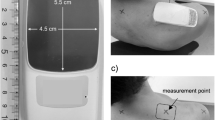Abstract
Objective
To observe the influence of pressing force and time on the thermal effect of An-pressing manipulation.
Methods
Eight healthy volunteers were recruited to receive An-pressing manipulation at Xinshu (BL 15) on the right side. The pressing force and time were both divided into five levels: the force described as extremely mild, mild, moderate, strong and extremely strong and time given by 2.5 min, 5.0 min, 7.5 min, 10.0 min and 15.0 min. The real-time change in local acupoint temperature as well as the change during 1.0-15.0 min after the manipulation were observed.
Results
Compared with the baseline data, the real-time changes in the temperature after An-pressing Xinshu (BL 15) on the right side with different levels of force (from mild to strong) were respectively (1.88±0.64) °C, (2.05±0.68) °C, (2.25±0.59) °C, (2.35±0.61) °C and (2.32±0.69) °C; the changes in 15.0 min after the manipulation were respectively (–0.11±0.11) °C, (0.03±0.14) °C, (0.59±0.58) °C, (1.38±0.70) °C and (2.09±0.98) °C. The real-time temperature changes after the manipulation for different durations (from short to long) were respectively (1.94±0.37) °C, (2.33±0.29) °C, (2.49±0.31) °C, (2.51±0.39) °C and (2.41±0.55) °C; the changes in 15.0 min after the manipulation were respectively (0.53±0.49) °C, (0.33±0.30) °C, (0.52±0.33) °C, (0.55±0.38) °C and (0.76±0.36) °C.
Conclusion
The thermal effect presented an increasing tendency with the extension of pressing time, and the temperature reached the top at 7.5 min; the thermal effect showed an increasing tendency with the rise of pressing force, and the temperature reached the top upon a moderate level of force. The pressing time can produce a greater influence on the real-time temperature than the pressing force; the pressing force can produce a greater influence on maintaining the temperature than the pressing time.
摘要
目的
观察力度和按压时间对按法热效应的影响。
方法
招募8 名健康志愿者, 分别以五个等级力度(极轻度、轻度、中度、重度和超重度)和五个等级按压时间(2.5 min、5.0 min、7.5 min、10.0 min 和15.0 min)按压志 愿者右侧心俞穴, 观察按压后即刻和1.0-15.0 min 穴位局部温度的变化情况。
结果
不同按压力度(从轻到重)按压右侧心俞穴后, 与按压前温度比较, 即刻温度变化分别是(1.88±0.64) °C、(2.05±0.68) °C、(2.25±0.59) °C、(2.35±0.61) °C和(2.32±0.69) °C; 按压后15.0 min 温度变化分别是(–0.11±0.11) °C、(0.03±0.14) °C、(0.59±0.58) °C、(1.38±0.70) °C 和(2.09±0.98) °C。不同按压时间(从短到长)按压后即刻温度变化分别是(1.94±0.37) °C 、 (2.33±0.29) °C、(2.49±0.31) °C、(2.51±0.39) °C和(2.41±0.55) °C, 按压后15.0 min 温度变化分别是(0.53±0.49) °C、 (0.33±0.30) °C、(0.52±0.33) °C、(0.55±0.38) °C和(0.76±0.36) °C。
结论
随着按压时间的延长, 热效应有增加的趋势, 按压时间为7.5 min 时升温最高; 随着按压力量的增加, 热效应有增加的趋势, 中度力量按压时升温最高。按 压时间对即刻温度的影响比按压力度大, 而按压力度对温度保持时间的影响比按压时间大。
Similar content being viewed by others
References
Liu H, Han XH, Yang GS, Su GF, Wang FL, Wang DQ. Preliminary analysis of the origin and application of An-pressing manipulation. Neimenggu Zhongyiyao, 2013, 32(28): 120–121.
Xie QY, Liao J, Huang PP, Zheng CS, Zhang L, Zheng JX. The research into pressing points of ancient and modern times. Henan Zhongyi, 2016, 36(6): 1084–1086.
Huang PP, Liao J, Zheng CS, Zhang L, Xie QY, Zheng JX. The literature study of pressing manipulation. Zhongguo Zhongyi Jichu Yixue Zazhi, 2015, 21(3): 336–337.
Wang H. Science of Acupuncture and Moxibustion. Higher Education Press, 2008.
Qiu GC. The Measurement of Commonly Used Manipulative Force and Its Clinical Significance. Guangzhou: Master Thesis of Southern Medical University, 2005.
Li W, Li JS, Peng L, Liu XW, Wang DJ, Yang Z. The application of tuina classics plus clinical practice in teaching of An-pressing manipulation. Guangming Zhongyi, 2014, 29(6): 1327–1329.
Yu SN, Ma LZ, Guo ZH. Analyses of the kinematics and dynamics characteristics of the Chinese medical massage techniques. Shandong Ligong Daxue Xuebao (Ziran Kexue Ban), 2005, 19(3): 82–83.
Dai DC, Fang M. Normalized analysis on tuina manipulation applied in treating degenerative spondylolisthesis. Zhongguo Linchuang Kangfu, 2006, 10(39): 160–162.
Zeng K, Wang JW. Simple analysis on the embodiment of golden mean (Zhong Yong) thoughts in tuina. J Acupunct Tuina Sci, 2017, 15(1): 63–66.
Zhou Q, Cheng YW, Fang M, Zhong ZB, Jiang SC, Zhang H. Research of the standardization of An-pressing manipulation. Hubei Zhongyiyao Daxue Xuebao, 2012, 14(4): 34–36.
Cao RF. Tuina Exercises and Treatment of Diseases. Shanghai: Shanghai Scientific and Technological Literature Press, 1992: 70–75.
Wang GC. Science of Tuina Manipulations. Beijing: China Press of Traditional Chinese Medicine, 2003: 156–157.
Pei XH. Discussion of the treatment time of tuina. Anmo Yu Daoyin, 2002, 17(1): 6.
Xu BY. Preliminary discussion of the time-effectiveness of tuina. Hubei Zhongyi Zazhi, 2003, 25(1): 19.
Zha HP, Xiong YH. Biomechanical effect of manipulation maneuver and frequency. Zhongguo Linchuang Kangfu, 2004, 8(32): 72–76.
An GH, Yao F, Zhao Y. Preliminary discussion of the modern significance of the research of thermal effect of tuina manipulations. Zhongguo Minzu Minjian Yiyao, 2011, 20(24): 38.
Li X, Shi HY. Studies on the medical application of infrared imaging technology. Guoji Zhongyi Zhongyao Zazhi, 2013, 35(5): 466–468.
Yan XH, Yan JT, Gong L, Jiang SY. Study on standardization of tuina manipulation parameters. Shijie Kexue Jishu: Zhongyiyao Xiandaihua, 2015, 17(12): 2443–2450.
Li W, Peng L, Liu XW, Li JS, Li TL. Establishment of comprehensive evaluation system of ‘tuina’ manipulation practice: the examples from Hunan University of Chinese Medicine. Hunan Zhongyiyao Daxue Xuebao, 2016, 36(6): 93–96.
Zhu MX. The mechanical analysis and clinical observation of elbow An-pressing manipulation as the major treatment for 25 cases of iliolumbar ligament injury. Zhongyi Waizhi Zazhi, 2012, 21(4): 42–43.
Acknowledgments
This work was supported by Key Project of Hunan Province Administration of Traditional Chinese Medicine (湖南省中医药管理局重点课题项目, No. 201721); General Project of Hunan Province Administration of Traditional Chinese Medicine (湖南省中医药管理局一般 项目, No. 2016106).
Author information
Authors and Affiliations
Corresponding author
Rights and permissions
About this article
Cite this article
Li, W., Jiang, Qr., Ai, K. et al. Experimental study on the influence of pressing force and time on thermal effect of An-pressing manipulation. J. Acupunct. Tuina. Sci. 16, 303–309 (2018). https://doi.org/10.1007/s11726-018-1062-y
Received:
Accepted:
Published:
Issue Date:
DOI: https://doi.org/10.1007/s11726-018-1062-y




